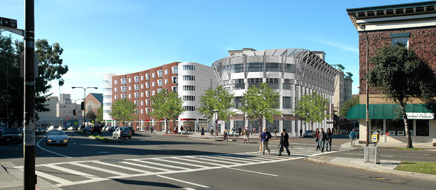The buzz of activity at a typical city hall grinds to a halt between Thanksgiving and January 2. But the mayors of Berkeley, Oakland, Richmond and Emeryville were determined not to let the holiday season slow the momentum of their joint plan to nurture a strong, regional green economy.

Artist rendering of the David Brower Center, a platinum level LEED building under construction in downtown Berkeley. The Brower Center will be a 50,000 sq. ft. cultural and education facility, and was designed green from top to bottom. The facility is expected to open in 2009. Image courtesy of the David Brower Center
By Bill Picture
Published: February, 2008
The plan for the East Bay Green Corridor Partnership, a collaborative effort between the four East Bay cities, the University of California, Berkeley and the Lawrence Berkeley National Laboratory, was announced at a news conference on December 3. At the conference, the mayors indicated that the first order of business would be securing federal money for the creation of a regional job training program to prepare locals to meet the demands of the emerging green job market.
Cisco DeVries, Chief of Staff to Berkeley Mayor Tom Bates, says that the participating cities took advantage of the holiday lull in civic business that followed the announcement to confer with their representatives in Sacramento and draft a formal proposal for the federal money, which they expect to submit soon. We’re going to submit a joint request for the green job money, and that request is almost done, he explains.
Power in numbers
The idea behind this first-of-its-kind alliance between neighboring cities is simple: there is power in numbers. Because the money needed to fund green projects and programs can be difficult for a city to come by on its own, the four mayors decided to better their chances by joining forces to create a unified green front.
Richmond Mayor Gayle McLaughlin, the first Green Party candidate to be elected mayor of a major American city, explains that the coalition will allow neighboring cities that had once competed for federal dollars to instead utilize each other’s unique strengths and talents, and build on each other’s successes. The clear flow of information and ideas is very important, she says. We need to break past the artificial barriers that separate one jurisdiction from another.
At the December 3 press conference, Berkeley Mayor Tom Bates referred to the previous every city for itself style of local government as chauvinistic. Working together, he said, would ensure that he and his fellow mayors’ dreams of a world-recognized hub for green research, technology, business and industry in the East Bay would be realized. We want to make the East Bay the Silicon Valley of the green economy, he added.
Berkeley is currently home to more than 80 green businesses and has consistently been ranked one of the greenest cities in the country. Among the green projects currently in the works is the new David Brower Center, a four-story cultural and education facility. When it opens in 2009, the 50,000-square-foot facility, which is named after the founder of the Sierra Club Foundation, is expected to be one of a growing number of new buildings in the Bay Area to receive the highest-level of certification, platinum, under the Leadership in Energy & Environmental Design (LEED) guidelines established by the U.S. Green Building Council.
Train them and they will come
McLaughlin believes that the pool of qualified applicants created by the proposed job training program will serve as an incentive for new green businesses to settle in the region. Richmond, which has set its sights on becoming the country’s first green industrial city, has already implemented a similar job training program of its own. In addition to a summer jobs program that put more than 400 young people to work last year, the city’s construction jobs training program, Richmond BUILD, has partnered with Solar Richmond, an organization promoting sustainable energy in Richmond, to provide instruction in solar panel installation to low-income residents.
The federal funds we are seeking would build onto these programs, says McLaughlin, who happily adds that a good number of the solar program’s graduates have already found work with Bay Area solar systems providers.
But it’s not just new businesses that are excited about the prospect of having more qualified workers to fill the growing number of so-called green-collar jobs, according to Berkeley Chief of Staff Cisco DeVries. It’s been really exciting to see the interest already generated from the corporate side, he says. They have a lot of interest in supporting this, aside from public relations. PG&E, for instance, is going to lose a large part of its workforce in the coming years because employees are retiring. And they want people trained and ready to take those jobs. So there’s an interesting nexus between their needs and our desire to build this kind of an economy.
There’s no I in team
While each city’s role in the partnership is still being defined, every one brings with it to the table an impressive green scorecard.
Oakland, for instance, produced more watts of solar power last year than any other city in Northern California, and was the first city in the nation to pledge a timeline for oil independence. On the green building front, the new offices of the Alameda County Waste Management Authority are expected to receive a platinum LEED rating. And Mills College’s new Natural Sciences Building has already been certified platinum. Most recently, Oakland allocated $250,000 from its own city budget for the creation of a green job training program, the Green Collar Job Corps, which will provide instruction in home weatherization, green construction, green roof installation and solar panel installation to low-income residents. This will allow us to deal with pollution and poverty simultaneously, explained Oakland Mayor Ron Dellums during his first State of the City address on January 14.
UC Berkeley spokesperson Marie Felde says that the university’s participation in the East Bay Green Corridor Partnership is a logical extension of the work already being done on campus to promote sustainability. In addition to its ongoing efforts to better manage energy use and utilize sustainable materials and building practices in campus construction projects, UC Berkeley recently created a new Director of Campus Sustainability position, which it expects to fill by January 2009.
As for the role that UC Berkeley and the Lawrence Berkeley National Lab will play in the East Bay Green Corridor Partnership, Felde expects it will be slightly lower profile, but key nonetheless. I see [UC Berkeley] helping provide the brainpower, she says. Already a lot of the employees of these [green] businesses are Berkeley graduates. And the research being done at Lawrence Berkeley National Laboratory will create new green business opportunities locally. History has already shown that, when the research is done here, the [resulting] businesses [that utilize the technology] tend to stay in the area.
Last year, the Lawrence Berkeley National Laboratory partnered with global energy firm BP, UC Berkeley and the University of Illinois at Urbana-Champaign to found the Energy Biosciences Institute, a multi-million dollar research institution dedicated to the development of alternative energy sources, including biofuels.
Keep ‘em hoping
There’s no way of knowing yet whether the Green Corridor idea will be a contagious one, though the rest of the country is sure to be keeping a close eye on the partnership’s progress. Nonetheless, McLaughlin is confident that the plan will help further reinvigorate the economy of the once heavy-industry-dependent city of Richmond, and raise the spirits of local residents. That success, she prays, will inspire other communities, particularly disadvantaged ones, to connect the dots between the economic challenges they face and pressing environmental issues, both for their own sake and the sake of the environment.
I see Richmond as setting an example for how an urban city can transform itself, she says. We have a profound commitment to issues of environmental justice, and see ourselves as a model for other cities.
In his State of the City address, Oakland Mayor Ron Dellums told voters that he envisions Oakland playing a similar leadership role.
It’s our destiny to lead, he said. One of the factors that will drive the growth of cities in this country are the challenges of global warming and environmental protection. We’re dealing with the old business of poverty and unemployment and hopelessness, and the new challenge of preserving our environment by bringing them together.

The City of Richmond has partnered with the non-profit organization Solar Richmond to train locals to install solar panels. Federal money would help expand the program. Photo courtesy of SolarRichmond.org

This bronze sculpture, located in the new platinum level LEED rated Natural Science Building at Mills College in Oakland, captures rainwater, which is then used to flush toilets. Photo by Cesar Rubio.

